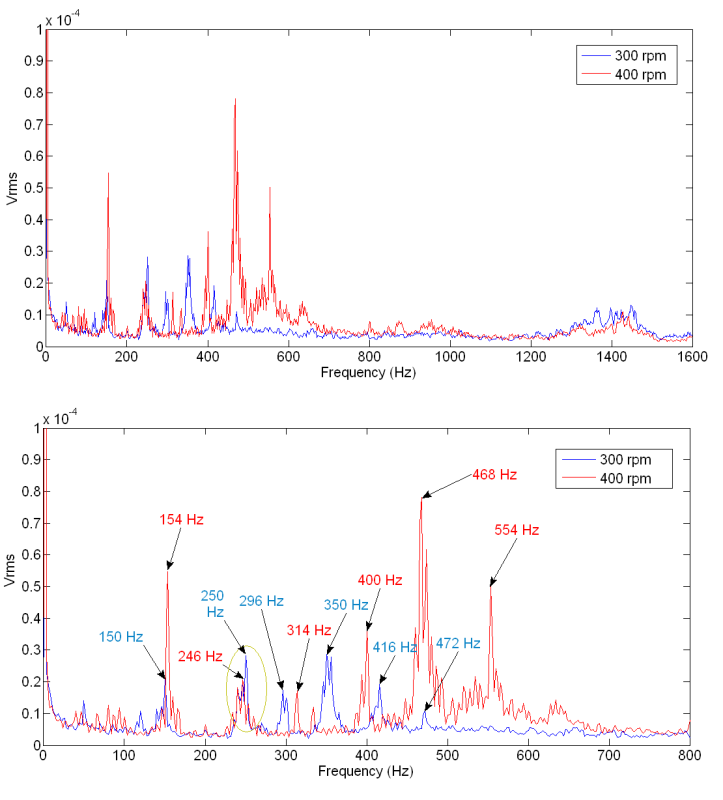onemilimeter
Electrical
- Jul 25, 2009
- 54
Hi,
My background is in electrical engineering. I wish to analyse the vibro-acoustics of a 3-phase permanent magnet brushless machine. I'm aware that vibration or acoustics noise can be generated "electromagnetically" (due to MMF, airgap field, etc) or/and "mechanically" (e.g. misalignment, eccentricity, unbalanced load, bearing, brush/commutator, etc.). As I need to analyse the vibro-acoustics of the PM motor at various loads, the PM motor must be attached to a DC machine (armature winding connected to a variable resistive bank), which acts as a load during testing (see attached image). I'm aware that, in practice, it is very difficult to avoid misalignment and eccentricity. In other words, there will be some degrees of misalignment or eccentricity in real world setup. As I'm interested only in "electromagnetically" induced vibrations and acoustics noise, I wish to distinguish "electromagnetically" induced vibrations and acoustics noise from that of mechanically induced.
I've the following instruments: dynamic signal analyser, PCB accelerometer, and sound pressure meter. The accelerometer is attached (using wax) to the motor under test.
Questions:
[Case-1] The PM motor is not excited, i.e. the winding terminals of the PM motor are left open. In this case, the PM motor is driven by the DC machine (i.e. the DC machine acts as a motor now), e.g. at 1000rpm (rated speed of the PM motor). What is the information that we can extract from the vibration reading measured by the accelerometer? Can we use this experiment to identify "mechanically" induced vibrations?
[Case-2] If the winding terminals of the PM motor are connected to a 3-phase resistive load (in such a way that the current flows in each phase winding is the rated phase current of the motor), and like in Case-1, it's driven by the DC machine at 1000rpm, what is the information that we can extract from the vibration reading measured by the accelerometer?
As I'm a novice in vibro-acoustics test, please correct me if any of my comment is wrong. Please also kindly suggest if you have better options to identify "mechanically" induced vibration and acoustics noise of my experimental setup.
Thanks
My background is in electrical engineering. I wish to analyse the vibro-acoustics of a 3-phase permanent magnet brushless machine. I'm aware that vibration or acoustics noise can be generated "electromagnetically" (due to MMF, airgap field, etc) or/and "mechanically" (e.g. misalignment, eccentricity, unbalanced load, bearing, brush/commutator, etc.). As I need to analyse the vibro-acoustics of the PM motor at various loads, the PM motor must be attached to a DC machine (armature winding connected to a variable resistive bank), which acts as a load during testing (see attached image). I'm aware that, in practice, it is very difficult to avoid misalignment and eccentricity. In other words, there will be some degrees of misalignment or eccentricity in real world setup. As I'm interested only in "electromagnetically" induced vibrations and acoustics noise, I wish to distinguish "electromagnetically" induced vibrations and acoustics noise from that of mechanically induced.
I've the following instruments: dynamic signal analyser, PCB accelerometer, and sound pressure meter. The accelerometer is attached (using wax) to the motor under test.
Questions:
[Case-1] The PM motor is not excited, i.e. the winding terminals of the PM motor are left open. In this case, the PM motor is driven by the DC machine (i.e. the DC machine acts as a motor now), e.g. at 1000rpm (rated speed of the PM motor). What is the information that we can extract from the vibration reading measured by the accelerometer? Can we use this experiment to identify "mechanically" induced vibrations?
[Case-2] If the winding terminals of the PM motor are connected to a 3-phase resistive load (in such a way that the current flows in each phase winding is the rated phase current of the motor), and like in Case-1, it's driven by the DC machine at 1000rpm, what is the information that we can extract from the vibration reading measured by the accelerometer?
As I'm a novice in vibro-acoustics test, please correct me if any of my comment is wrong. Please also kindly suggest if you have better options to identify "mechanically" induced vibration and acoustics noise of my experimental setup.
Thanks

